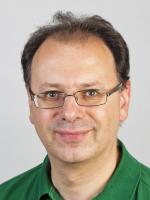
Professor of Theoretical Chemistry
The work of our group is primarily focused on the electron correlation problem - namely how to compute the correlation energy for an atom, molecule, or even solid, starting from a mean-field (say Hartree-Fock) description of the system. Our approach is to combine quantum chemical ideas with stochastic (Monte Carlo) techniques, which enable us to tackle problems which are very difficult to solve use standard quantum chemical techniques alone.
We are developing Quantum Monte Carlo algorithms adapted for electronic (and more generally Fermionic) problems by working in Slater determinant spaces. The central problem which is encountered is the infamous "Fermion sign problem", which results from electronic wavefunctions having both positive and negative amplitudes. Currently we are working on a novel population dynamics algorithm which propagates walkers in Slater determinant space according to a type of "stochastic cellular automaton" obeying simple rules. The movie on the home page of our research group website shows an evolving population of walkers of positive and negative sign settling on the FCI wavefunction of a nitrogen dimer in a minimal basis - an archetypal multireference system. The remarkable aspect of this dynamics is the spontaneous symmetry breaking caused by annhilation processes, allowing the exact nodal surface of the nitrogen molecule, as expressed by the CI coefficients, molecule to appear. No fixed-node approximation is applied.
Further animations of this method in action can be viewed here.
Publications
- Page 1

